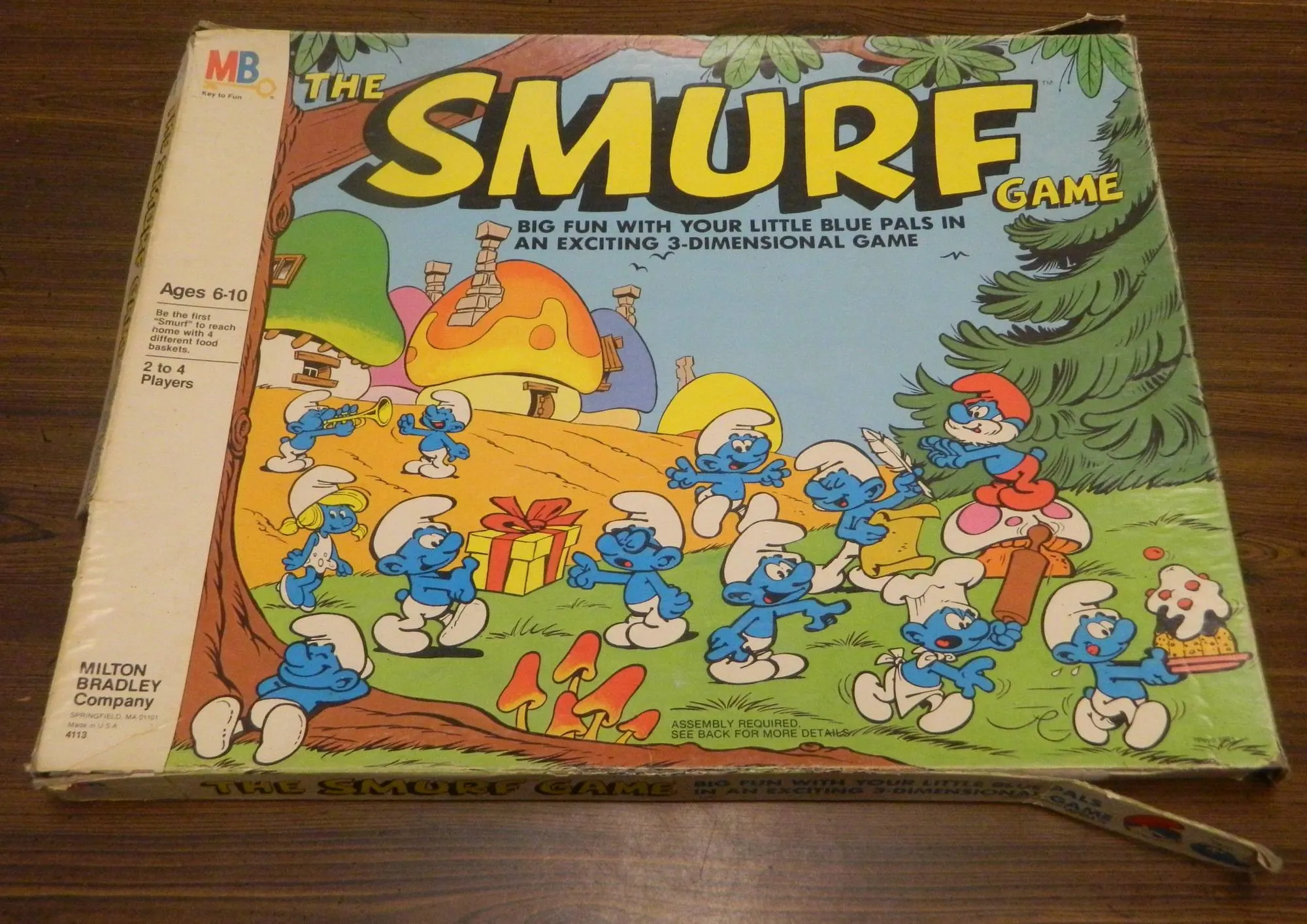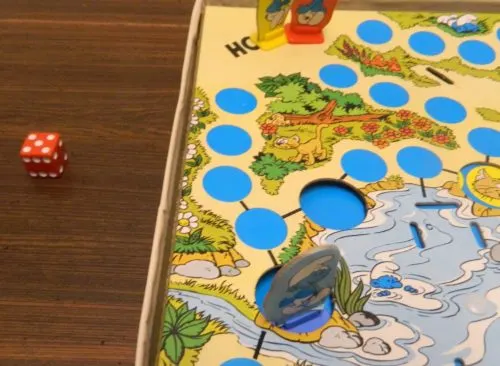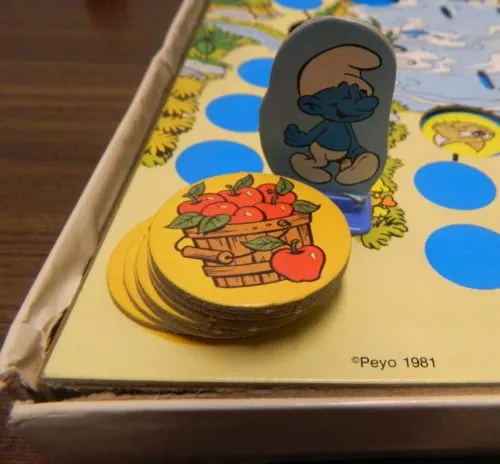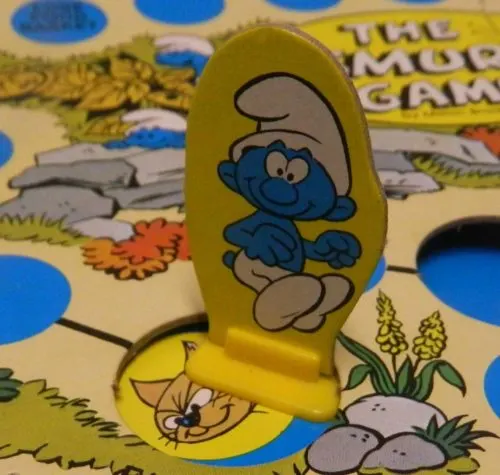The Smurfs were originally created back in 1958 by the Belgian comics artist Peyo. The Smurfs are a group of small blue creatures who live in the forest with names based on their primary characteristic. While initially only popular in Europe, the Smurfs popularity rose in the United States after Hanna-Barbera created a television series back in 1981. The television show ran until 1989 and became a pop culture phenomenon in the 1980s. Like everything that was ever popular, this lead to a lot of merchandising which included board games. The Smurfs in particular where quite popular for board games as there were six different Smurf board games released during the show’s initial run. Today I am looking at the 1981 The Smurf Game. I can’t say that I had high expectations for The Smurf Game because it looked like your typical cash in game. The Smurf Game is exactly what you would expect it to be, a generic children’s roll and move game made to cash in on the popularity of the television show.
How to Play The Smurf Game
Setup
- Set the gameboard up by inserting the terrain pieces into the corresponding spaces on the game board.
- Sort the food basket discs by type and place them next to the corresponding section on the gameboard.
- The players choose a color and place the corresponding pawn on the home space.
- Turn the two dials so one small hole is on both sides of the section where you turn the wheels.
- The players take turns rolling the die. The player who rolls the highest number will start the game. The game will then proceed clockwise.
Playing the Game
On a player’s turn they can take one of two actions:
- Roll the die and move their pawn the corresponding number of spaces.
- Turn one of the two wheels one space counter-clockwise. To turn the wheel one space counter-clockwise, the players will move the small circle from the left side of the gap to the right side.
If a player decides to move they will roll the die. The goal is to reach one of the four food areas located around the game board. When moving a player has to use their full roll (except when collecting a food basket). Each space that a pawn moves over counts as one space. The player can move their pawn in any direction but they can’t move their pawn over the same space two times in the same turn. A player is never able to move through a space which features Azrael, the cat. If a player is stuck between two spaces which contain a cat, the player cannot move. They can either turn one of the wheels or skip their turn. Players are also unable to land on spaces occupied by another player’s pawn. If a player would land on a space occupied by another player, they will move their pawn to the next unoccupied space.
When a player reaches one of the food basket locations, the player can stop moving their pawn even if they had spaces remaining. They will then collect one of the corresponding food basket discs. On the player’s next turn they will move off the space. If the player chooses to move back to the space on a future turn, they can pick up another basket disc (max of two).
If a player chooses to turn one of the wheels, they will turn the wheel they chose one space counter-clockwise. The players will then see how turning the wheel altered the game board. Cats that previously blocked paths may have moved opening up the paths they blocked. If a cat shows up on a space that is occupied by a player’s pawn, the player who controls that pawn has to return one of their food baskets (their choice) to the corresponding section of the game board. The same happens when a player lands on a “lose food basket” space. If a player has no food basket discs when they land on one of these spaces, they move their pawn back to the home space instead.
End of Game
Once a player has acquired at least one food basket for all four types of food, the player can start heading back to the home space.
The first player to land on the home space by exact count with one disc of each type of food, wins the game.
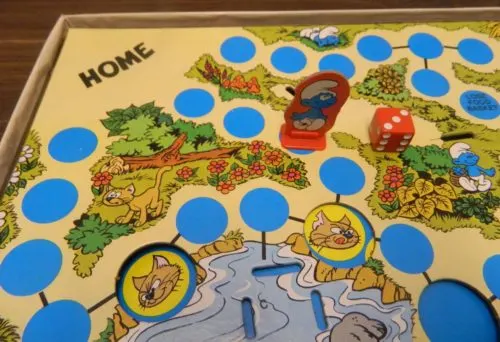
The red player has acquired all four types of food. They rolled a three so they can land on the home space by exact count. This player has won the game.
My Thoughts on The Smurf Game
Before I get into the details of the game itself, I want to begin by saying that I have never been a big fan of the Smurfs. I think this has to do with the fact that the Smurfs came out a little before my time. By the time I was old enough to watch and enjoy cartoons, the Smurfs television show was already off the air for a couple years. Thus I never really grew attached to the franchise because I never watched it when I was a kid. I bring this up because when analyzing The Smurf Game I didn’t have the nostalgia from the television show impacting my opinion of the game. Therefore fans of the cartoon may enjoy the game quite a bit more than I did.
My expectation for The Smurf Game was that it was going to be another very generic children’s roll and move game based on a popular franchise. It turns out that my initial impression was basically spot on as that is what The Smurf Game is. The basic gameplay revolves around rolling the die and moving your Smurf around the game board. The ultimate goal is to acquire at least one basket of each type of food and then return to the home space before the other players. If you have ever played one of these type of games before, you should already know what to expect out of The Smurf Game.
While The Smurf Game plays like most children’s roll and move games from the 1980s and 1990s, there are a couple areas where the game differs.
The Smurf Game has little strategy to it, but I would say that it still has more than your typical children’s roll and move game. The first area where the game adds a little strategy is that you can choose to acquire a second copy of any of the baskets. This adds a little risk/reward strategy to the game. You could decide to forgo getting a second copy of a basket which allows you to move onto the next food item quicker. If you lose a food basket though you will be forced to go back and waste time recollecting the item. Otherwise you can spend two turns to get a second copy of an item. This gives you some protection so you don’t have to revisit any of the food areas on the game board. If you make sure to collect an additional basket at two or three of the locations you shouldn’t have any need to return to any of the food locations.
A small amount of strategy also starts to creep into The Smurf Game because the game board can become quite congested at times. If multiple players try to go after the same food items at the same times, there are going to be times where players get in each other’s way. This usually isn’t a big problem as you just move to the next available space. This can be a problem though when a player wants to land on one of the food spaces but another player is already blocking it. A player can really mess with another player’s strategy if they can occupy the space when another player wants to land on it. The other player will then either have to waste a turn waiting for them to move off the space or they will have to alter their strategy. This is not something you can really pre-plan, but if possible you probably want to sneak into a food location before another player can.
The final area where The Smurf Game adds a little strategy, and thus differentiates itself from most children’s roll and move games, is the ability to rotate the two wheels on the game board. There are basically two times when you are going to want to turn the wheel. First if a player is sitting on one of the wheel spaces and the current player thinks turning the wheel will make a cat appear on the space, it is a good idea to turn the wheel. This forces the player to lose one of their food baskets. If the player didn’t get a backup basket, they will then have to go back to one of the areas they have already visited which will make them lose a lot of time
The other time to turn the wheel is when a cat blocks your path. In these situations you have to decide whether it would be better to roll the die and take a different path or spend one turn hoping to clear the cat out of the path you plan on taking. Most of the time you are probably better off using your turn to turn the wheel as it will save you time. There is a hidden strategy here though. If you and another player both need the wheel to be turned, if possible it is better to make the other player waste their turn turning the wheel. Then you can use your turn to either acquire another basket or get closer to your next destination.
Outside of those three small tweaks, The Smurf Game is pretty much like every other children’s roll and move game. This can be seen as both a positive and negative. On the negative side the game is pretty boring for older children and adults. The few decisions in the game are quite obvious to the point where it feels like the game kind of plays itself. Therefore the game relies heavily on luck as the player who rolls best is likely going to win the game. On the positive side the game is quite easy to play and plays pretty quickly. This should make the game appeal to younger children. When you add in the Smurf theme, I think younger children could have fun playing the game.
The fact that The Smurf Game is a pretty generic children’s roll and move game means that it has to have one of the mechanics that I hate most from this genre. Maybe it is just me but I have always hated the mechanic where you have to land on the finish space by exact count in order to win the game. I can understand the idea behind the mechanic as it keeps all of the players in the game until the very end. I have always felt that this mechanic feels like a cheap catch up mechanic though. It doesn’t matter how well you do in the rest of the game if you can’t roll the right number at the end of the game. You could be in last place for the entire game and still win just because you were the first player to roll the right number at the right time.
The Smurf Game’s component quality is what you would expect from a 1980s Milton Bradley game. Basically the entire game is made out of cardboard. I do appreciate the 3D gameboard despite the fact that the cheap copy of the game I found at a rummage sale was missing most of the 3D elements you add to the board. I have always liked these type of 3D boards as they add to the game’s theme. I also think the game’s artwork is pretty well done as the game does a good job utilizing the Smurf theme. Fans of the Smurfs should appreciate the game’s art style. While not highly original, I also appreciate the gameboard having the wheels which change up the game board from time to time. The only real problem I had with the components is that they are pretty generic. They serve their purpose but they aren’t anything special.
Should You Buy The Smurf Game?
While I was hoping it would do something new, The Smurf Game ended up being just another pretty generic children’s roll and move game. You roll the die, move around the game board collecting stuff, and then race back to the start. The game has a couple unique features that add a little decision making/strategy to the game. They still aren’t enough to overcome the fact that The Smurf Game basically plays like every other children’s roll and move game. I think younger children and fans of the franchise might enjoy the game, but it will get boring quickly for older children and adults.
Older children and adults who don’t really enjoy the Smurfs franchise probably won’t get much out of The Smurf Game. While The Smurf Game is not a good game, I could see younger children and adults who grew up with the franchise having some fun with the game. I would only recommend picking up the game though if you could get a really good deal on it.
If you would like to purchase The Smurf Game, you can find it online: Amazon, eBay

